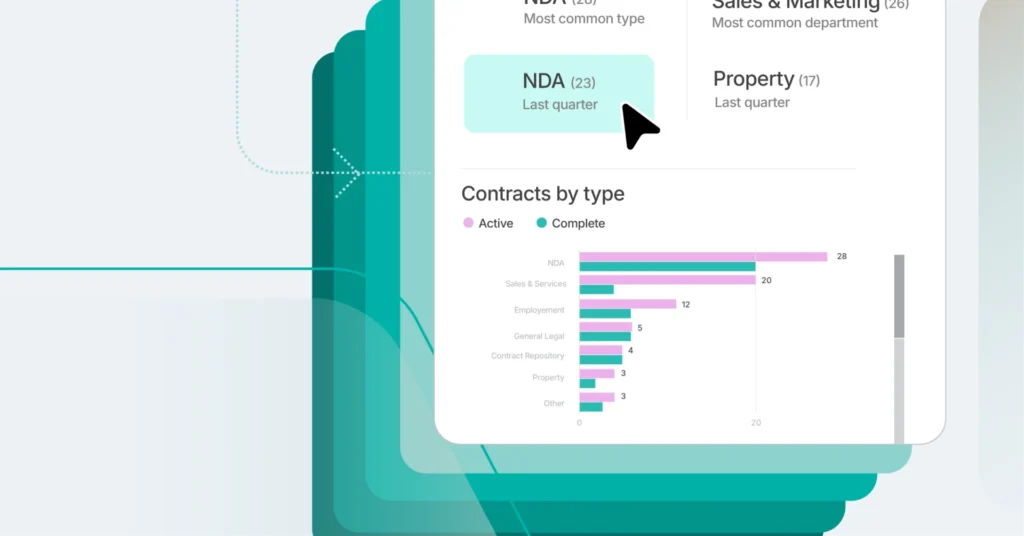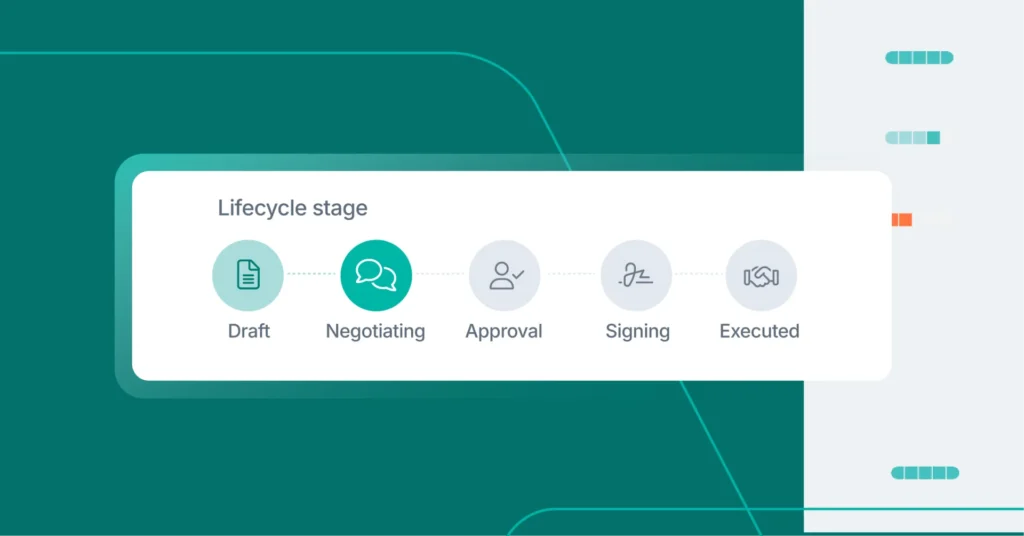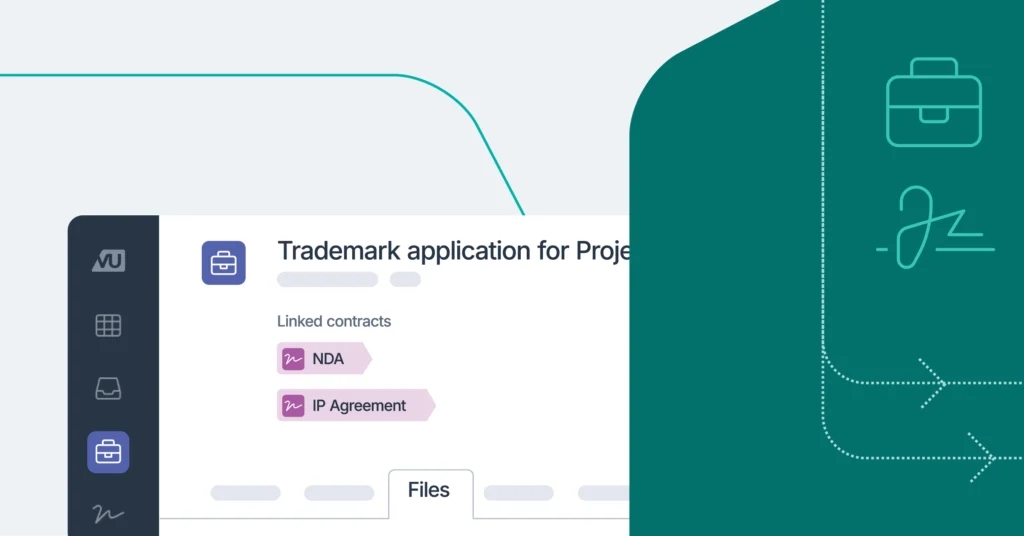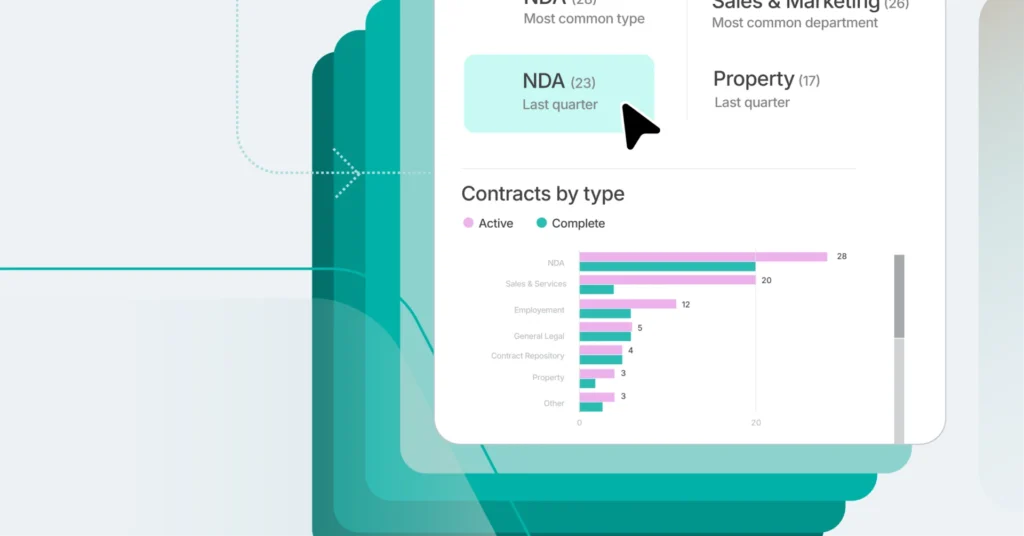5 benefits of contract management software (that you might be missing out on)

Contracts are not just central to the in-house legal function – they are the backbone of your business. From cost efficiency to risk management, you can tell a lot about an organization from the way it manages its contracts – from manual processes, point solutions and ELMs at one end of the spectrum to consolidated workspaces at the other.
But with ever-growing pressure to do more with less, and efficiency remaining the number one priority for in-house legal teams (The 2024 In-house Legal Technology Report), settling for a chaotic contract lifecycle management system is like building a house on sand.
In this article, we consider how traditional approaches to contract management stack up against the demands facing modern in-house legal teams, before delving into the benefits you may be missing out on with your current contract management software. Finally, we’ll explore the merits of an alternative approach to contract management – the legal workspace.
Traditional approaches to contract management
At its core, the purpose of contract management is simply to manage and execute the end-to-end process of the contract lifecycle in the most efficient way possible. With that in mind, let’s unpack some of the traditional approaches to contracts that legal teams tend to rely on.
Manual processes
For many legal teams, wrestling with paper contracts between parties for signature and storage remains a reality of everyday work. While many do utilize simple technology to assist with contract workflows, this is often done in a very basic way – for example, using emails to collaborate on drafts, spreadsheets to keep track of progress, or storing contracts on external hard drives.
ELMs and point solutions
For other legal functions, rudimentary contract management systems may have already been a staple of their workflows for some time – either in the form of ELMs or standalone document management systems. These are sometimes legacy tools inherited from other areas of the business and are not always designed for the nuances of legal work.
Pros of traditional approaches to contract management
There’s arguably nothing wrong with spreadsheets, emails and paper files – they have, after all, served many of us adequately in the past. Keeping things simple can work when you’re not operating at scale or volume – and you’ll avoid the inevitable, albeit temporary, inconvenience of any pesky technology implementation processes. Investment in a point solution or ELM for contract management may also make sense for teams seeking advanced features to address a specific problem.
Sticking to the old ways can also be kind on your budget – at least in the short term. However, this should be taken with a pinch of salt – for reasons that we’ll dive into next.
Cons of traditional approaches to contract management
Contracts are more than just the bread and butter of everyday legal work. They are the glue holding together the legal and financial relationships on which every organization depends – from client and vendor deals to employee and partnership agreements. Despite being often managed in silo from other workflows, the reality is that no contract exists in a vacuum.
For this reason, it’s essential that your contract management system reflects the connection between your contracts and the rest of your workflows – optimizing your overall operational and financial performance while reducing exposure to risk. Here are some of the ways that traditional approaches fall short of this objective.
Disconnection = inefficiency
The research is clear – disconnected contract management systems are causing efficiency losses for legal teams. Although our data signals a shift toward a growing number of businesses embracing consolidated tech stacks, The 2023 In-house Legal Technology Report found that the average in-house legal team is still using an average of four technology solutions to manage their workflows.
That’s an awful lot of software to purchase, implement, adopt and manage – and that’s before you even get to getting your contract management system in sync with its counterparts. With so much going on, it’s no surprise that 61 percent of teams still spend over an hour per day jumping between systems to gain oversight of their work, or that one of their biggest pain points experienced with multiple platforms is lack of integration.
The scale of the problem is magnified when you consider that contracts aren’t exclusive to legal – they are also at the heart of many other business functions, from sales and finance to HR and compliance. Even if these departments are using the same contract tools, bottlenecks are likely to form as the volume of users navigating these systems increases.
Time is a precious asset – and these cumulative hours spent jumping between systems are worth a lot to your business (if you don’t believe us, find out how much this could be costing your own business here!). This is not just time which could be better spent delivering legal services to your organization – it is an administrative black hole which keeps you from higher-level strategic work.
This concern is echoed by respondents to The 2024 In-House Legal Technology Report, with 80 percent convinced that time spent on manual activities takes time and effort away from working on larger business goals. Without comprehensive integration with connecting workflows, it’s a big ask for any single point solution to resolve this problem alone.
Limited visibility
Your legal team might be putting in the hours when it comes to your contract workflows, but without a central system of record, it’s difficult to keep track of when, where, and by whom this work is being completed. This makes it incredibly tough to prioritize workloads or reallocate tasks if a team member is absent – let alone gain meaningful oversight into the efficiency or otherwise of your overall lifecycle management processes.
Inefficient reporting
Lack of oversight is also a big problem when it comes to reporting – particularly for in-house legal teams, who, compared to their peers in teams like sales and marketing, often lack the data tools needed to meaningfully quantify their output.
Scraping together data from multiple emails, spreadsheets and files is time-consuming, and ripe with risk for error. Even if you have extensive analytics data available from point solutions, this will still be siloed to individual workflows, and the process of consolidating and extracting actionable insights from this information can be a mammoth and time-consuming task. Ultimately, all of this can land your team in a weaker position than it deserves when it comes to wider company strategy, budgeting, and management decisions.
Poor data security
As companies fight to meet growing global privacy challenges, risk mitigation remains a key motivator behind the purchase of legal technology – and contracts are a hotbed of sensitive information which becomes high risk when processed through multiple point solutions. It’s every lawyer’s worst nightmare to realize that they’ve left confidential documents behind on public transport – and this remains a very real risk every time contracts are moved between physical or digital storage locations.
Contract management software – is there a better approach?
When you consider the collective pitfalls that come with traditional approaches to contract management, a clear picture emerges. Scattered systems provide a clunky user experience and come fraught with administrative headaches and wasted hours – all of which slow the business down and make legal’s job tougher.
For legal teams looking to break out of this cycle, a consolidated contract management software is a popular entry point. According to the ACC 2023 Legal Technology Report for In-house Legal Professionals, 65 percent of respondents are already using some form of CLM (Contract Lifecycle Management) system, with matter management systems coming a close second. The ACC report also tells us that 62 percent cited lack of interconnectivity as their top pain point when using multiple solutions – and 43 percent would prefer to simply invest in one comprehensive operating system from the outset.
The upshot of this industry feedback is clear – there is a strong business case for a single management solution which supports not just contracts, but all the work that legal does including matter management. That leaves us with an alternative approach to consider – a legal workspace.
The legal workspace approach to contract management – what is it?
A legal workspace, such as LawVu, is a consolidated platform which supports not just contract management, but document management, matter management, intake and self-service, and spend management too – along with insights and reporting. Handling all in-house legal work together in one legal workspace truly means the end of bouncing between systems and limited visibility of the work at play.
“What clinched it for us with LawVu was the easy-to-use interface and the fact that it combined all of the functions we needed, the matter management, the contract management, and the added element of having some automation.” – Craveable Brands
The benefits of contract management in a legal workspace
Connection = efficiency
Managing your contracts within a legal workspace generates a multitude of efficiency gains. Not only do AI-powered contract management features (such as self-service for routine contracts and AI-assisted data extraction) speed up turnaround times and streamline collaboration with the wider business, but having everything in one place allows legal to capitalize on these features even further.
Because a workspace approach connects contracts with their associated matters, it’s far easier to get a handle on the context surrounding your deals and streamline things even further. Imagine that a contentious clause or expiration date is flagged up in a contract using AI tools. Instead of resorting to email exchanges or sifting through files to resolve the issue, everything related to the matter is now at your fingertips – whether it’s a key date, financial information, or even a litigation issue affecting upcoming contract renewal. Getting across contract hurdles with less roadblocks keeps you – and your business – moving forward at pace.
“For a specific area of work, we might have two different vendors working on the same project and so by setting it up as a matter it automatically groups the contracts into one place. It just makes so much sense – all the contracts are there in the one matter.”- 4D Medical
Clear visibility
Because a workspace creates a single source of truth for all of your workflows – not just your contracts – it can give you a snapshot of everything you (and your team) are working on at any time. If a member of staff leaves your organization or goes on holiday, the rest of your team will maintain full visibility over their workload so that nothing falls through the cracks. Easy-to-use grid displays allow you to search, filter, sort and organize your contract files, and supporting features like AI bulk import lets you move legacy contracts into your system to create a central repository from day one.
This comprehensive system of record brings the wealth of insights that sit beneath your contracts to your fingertips, empowering you to immediately better manage and prioritize your team’s workload.
Actionable reporting
With automated reporting capabilities ready to go within LawVu’s legal workspace, it won’t be long before you can start drawing on all the data you’re surfacing to inform strategic decisions and form a strong business case for legal budgets and resourcing. With access to detailed reports not only on your contracts, but on all of the workflows that they relate to, you’ll have a far easier time showcasing the value of your team to senior leadership.
Robust data security
Managing your contracts securely within the same space as your matters, legal spend, and data insights is a sure-fire way to reduce the potentially costly privacy risks which are an inevitable consequence of passing documents between multiple systems.
Maximized ROI
Budgets are always a concern for in-house legal teams – and when you finally get a new technology investment over the line, your priority will be to see a return on it as quickly as possible. Not only is a workspace solution such as LawVu likely to be more economical than multiple point solutions, but fast implementation which gets you up and running in weeks (not months!) means you can hit the ground running. With an intuitive and easy-to-use platform which integrates with your existing software and provides ongoing business support, you’ll see tangible results in no time.
Ready to realize the benefits of contract management software in a legal workspace?
When you consider the substantial benefits that come from managing your contracts within a consolidated tech stack or legal workspace, it’s clear that traditional approaches simply cannot deliver the same impact on business outcomes. By opting for a comprehensive workspace solution, you will supercharge the efficiency not only of your contracts, but of your entire legal function – all the while building a solid foundation to support your wider business.
To learn more about the benefits of a workspace approach to legal contract lifecycle management, and how it can help you deliver better outcomes for your business, click here.



